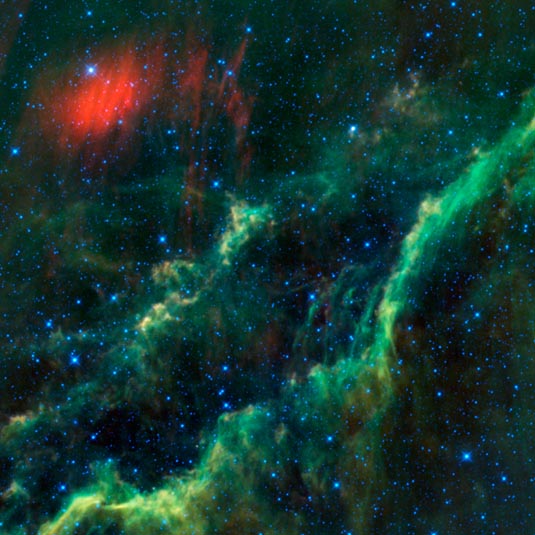
Description: Star, Star Formation Nebula
Position (J2000): Menkhib: RA: 03h 59m 00s Dec: +35° 46' 57"
California Nebula: RA: 04h 00m 52s Dec: +36° 27' 46"
Constellation: Perseus
Distance: 1,800 light-years away from Earth
Size: California Nebula: 100 light-years across
Field of View: 1.56 x 1.56 degrees
Orientation: North is 191.85 degrees left of vertical
Image Credit: NASA/JPL-Caltech/WISE Team
Release Date: May 7, 2010
ABOUT THIS IMAGE:
This infrared image from NASA's WISE (Wide-field Infrared Survey Explorer) features one of the bright stars in the constellation Perseus, named Menkhib (the bright star in the upper left near the red dust cloud) along with a large star forming cloud catalogued as NGC 1499, or more commonly called the California Nebula (running diagonally through the image).
Menkhib is one of the hottest stars visible in the night sky; its surface temperature is about 37,000 Kelvin (about 66,000 degrees Fahrenheit - over 6 times hotter than the Sun). Because of its high temperature it appears blue-white to the human eye (almost all stars appear bluish to WISE). It has about 40 times the mass of the Sun and gives off 330,000 times the amount of light. Menkhib is a runaway star, and the fast stellar wind it blows is piling up in front of it to create a shock wave in the gas and dust surrounding it in the space between the stars. This shock wave is heating up the dust within and WISE sees it as the red cloud in the upper left of the image.
Menkhib is part of an association of very hot stars that were born from the California Nebula only a few million years ago. These stars are lighting up the nebula; heating and ionizing it. In visible light, the ionized gas glows red, while in infrared light we see the heated dust (which appears in green and red in this image from WISE). The California Nebula gets its name due to a resemblance to the shape of the U.S. State of California (which you can just make out as outlined by the green dust if you rotate the image by a little more than 90 degrees clockwise). The entire California Nebula stretches across about 100 light-years, and we see about 80% of it in this view.
Menkhib and the California Nebula are about 1,800 light-years away from Earth. This is within the same spur of the Orion spiral arm of the Milky Way in which we are located.
All
four infrared detectors aboard WISE were used to make this image. Color
is representational: blue and cyan represent infrared light at wavelengths
of 3.4 and 4.6 microns, which is dominated by light from stars. Green
and red represent light at 12 and 22 microns, which is mostly light from
warm dust.
Color Mapping: 22
microns=Red, 12 microns=Green,
4.6 microns=cyan, 3.4
microns=blue